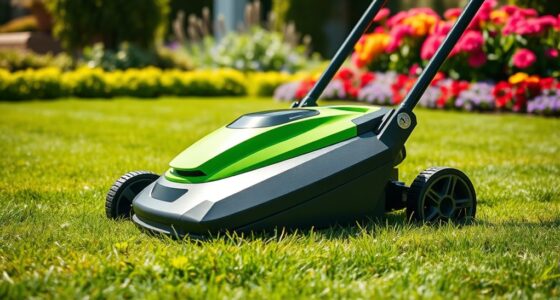If you’re looking for the best kids’ balance bikes that make learning to ride easy and fun, I’ve found some excellent options. From lightweight models with adjustable features to durable designs suited for different ages, these bikes promote balance and confidence while ensuring safety. Many come with puncture-resistant tires and simple assembly. Keep exploring, and you’ll discover even more details to help find the perfect fit for your child’s growing needs.
Key Takeaways
- Prioritize bikes with adjustable seats and handlebars to accommodate growing children and ensure proper, comfortable riding posture.
- Choose lightweight, durable frames made from aluminum or steel for easy handling and long-term safety.
- Opt for puncture-resistant foam or air tires suited for various terrains, minimizing maintenance and flats.
- Select models without pedals and training wheels to promote natural balance development and confidence.
- Ensure bikes meet safety standards like ASTM F963-11 and EN71 for reliable, child-safe riding experiences.
Chillafish Charlie Kids Balance Bike

If you’re looking for a beginner bike that helps your toddler develop balance and confidence, the Chillafish Charlie Kids Balance Bike is an excellent choice. It’s lightweight, weighing just 5.5 pounds, making it easy for little ones to handle. The adjustable seat and handlebar grow with your child, ensuring a perfect fit from 18 to 48 months. Its durable alloy steel frame can support up to 77 pounds, lasting for years. The no-puncture EVA tires provide smooth rides on various terrains without flats. Plus, the glow wheels add fun and excitement, encouraging your child to ride and build skills with confidence.
Best For: toddlers aged 18 to 48 months who are beginning to learn balance and coordination on a lightweight, durable bike.
Pros:
- Lightweight at just 5.5 pounds, easy for young children to handle and carry.
- Adjustable seat and handlebar to grow with your child, ensuring a comfortable fit.
- No-puncture EVA tires provide smooth, flat-free rides across various terrains.
Cons:
- Made with hard plastic tires, which may not absorb shocks as well as rubber tires.
- No built-in brakes, requiring supervision to ensure safe riding.
- Limited color options may not appeal to all children’s preferences.
KRIDDO Toddler Balance Bike for 2-3 Year Olds

The KRIDDO Toddler Balance Bike is an excellent choice for parents seeking a safe and durable way to introduce their 2-3-year-olds to cycling. It features a sturdy carbon-steel frame that can support up to 110 pounds, yet remains lightweight at just 6.6 pounds. The 12-inch wheels with puncture-resistant tires provide stability on various terrains like grass and sidewalks. Its adjustable handlebar and seat ensure a comfortable fit as your child grows. Safety is a priority, with soft rubber grips and a cushioned PU seat. Easy to assemble and carry, the KRIDDO makes learning to balance both fun and effortless.
Best For: parents of 2-3-year-old children seeking a safe, durable, and adjustable balance bike to introduce their kids to cycling and develop their balance skills.
Pros:
- Lightweight and easy for children to handle, weighing only 6.6 pounds.
- Adjustable handlebar and seat to accommodate growth, ensuring a comfortable fit as your child develops.
- Durable carbon-steel frame with puncture-resistant tires suitable for various terrains like grass, sidewalks, and driveways.
Cons:
- May be too basic for older children beyond age 3 who may want additional features or a larger size.
- Limited color options and customization features on some models (depending on the package).
- Requires assembly, which could be challenging for some parents without tools or experience.
SEREED Baby Balance Bike for 1 Year Olds and Toddlers
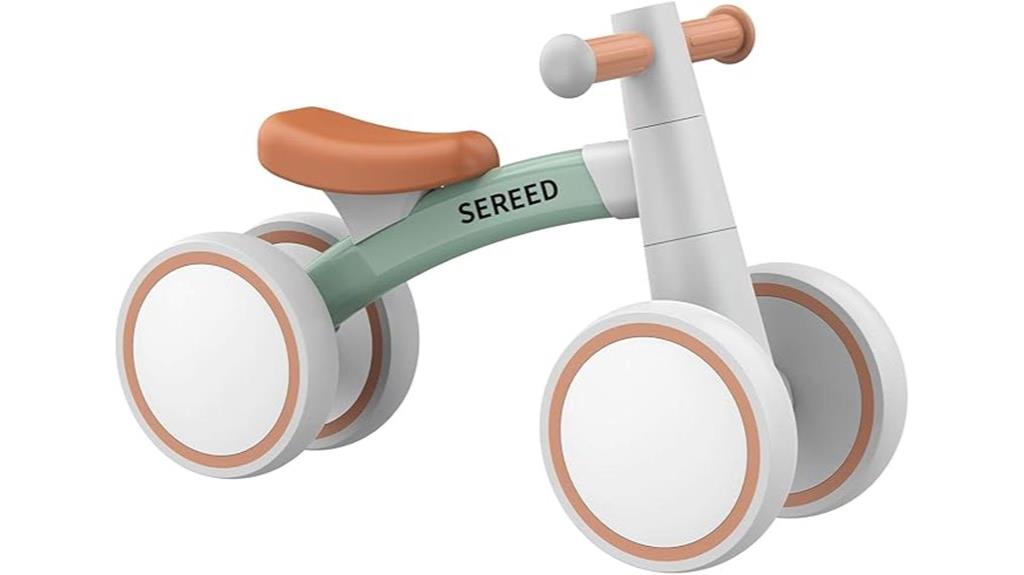
For parents seeking a safe and engaging first bike for their 12- to 24-month-olds, the SEREED Baby Balance Bike stands out as an excellent choice. Designed specifically for toddlers, it helps develop balance, coordination, and confidence while being easy to handle. Its lightweight aluminum alloy frame and non-slip TPU wheels make it durable, safe, and suitable for both indoor and outdoor use. The bike’s 135° gravity steering minimizes rollover risks, and the softly supportive polypropylene seat ensures comfort. With no pedals and a simple assembly, this bike encourages independent riding and prepares your child for their next biking adventure.
Best For: parents and caregivers seeking a safe, durable, and developmental first bike for toddlers aged 12-24 months to promote balance, coordination, and independence.
Pros:
- Lightweight and easy for children to maneuver, promoting independence and confidence.
- Safe design with no pedals, TPU wheels, and 135° gravity steering to minimize rollover risks.
- Durable, high-quality materials suitable for indoor and outdoor use, with simple assembly.
Cons:
- Limited to children up to 55 pounds, which may restrict use as the child grows older.
- No brakes or additional steering features, which might limit control for some children.
- Designed specifically for very young toddlers; older children may find it too small or limiting.
Balance Bike for Big Kids Aged 4-9 Years Old

Kids aged 4 to 9 who are still developing their balance and coordination will find balance bikes like the Bixe model especially helpful. These bikes are designed to make learning to ride safer, faster, and more enjoyable by focusing on balance and steering before pedaling. With a lightweight alloy steel frame, 16-inch wheels, and a sporty look, they support children up to 150 pounds. The bikes are easy to assemble, durable, and feature safety components like tamper-proof clamps. Many kids master balancing and steering within days, boosting confidence and independence. Overall, they’re an excellent, cost-effective choice for older kids starting their cycling journey.
Best For: children aged 4 to 9 years old who are learning to balance and steer before transitioning to a pedal bike, especially those seeking a lightweight, durable, and cost-effective option.
Pros:
- Lightweight alloy steel frame and aluminum wheels make it easy for kids to maneuver independently.
- Simple assembly with minimal tools required, and safety features like tamper-proof clamps ensure secure riding.
- Rapid skill development, often within days, boosting confidence and making learning to ride more enjoyable.
Cons:
- Some models lack adjustable seat height without tools, which may require additional adjustments as children grow.
- Minor issues such as tires losing air or loose handlebars can occur, though customer service is responsive.
- Slightly less heavy-duty compared to higher-end balance bikes, potentially affecting long-term durability for very rough use.
SEREED Toddler Balance Bike for 2-5 Years Old
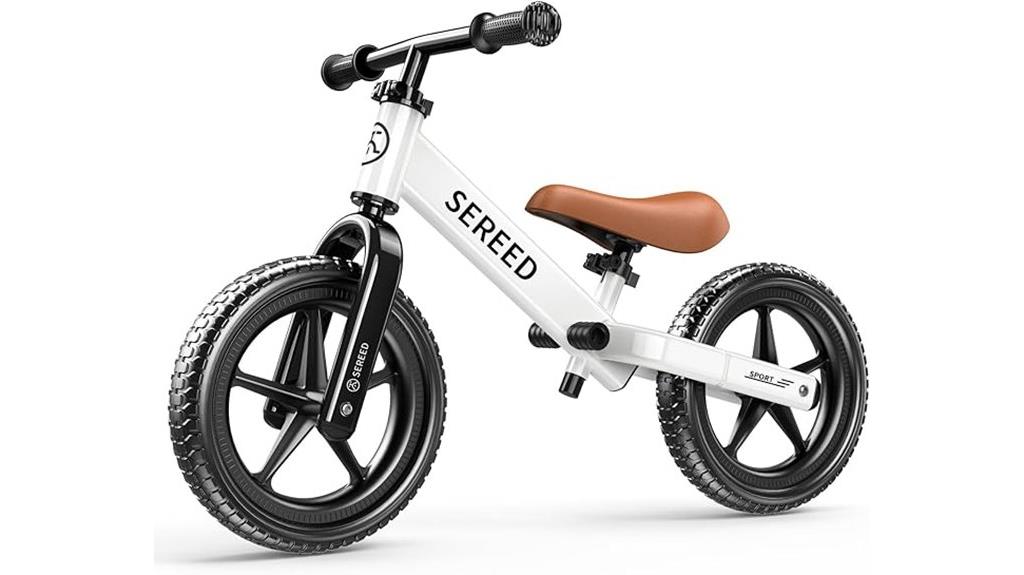
If you’re looking for a beginner-friendly bike that helps your child develop balance and coordination, the SEREED Toddler Balance Bike is an excellent choice for kids aged 2 to 5 years. Its sturdy white carbon steel frame supports up to 110 pounds, ensuring durability and safety. The lightweight design (only 3.5 kg) makes it easy for little ones to push, pull, and carry. Features like EVA foam airless tires, a soft rubber saddle, and adjustable seat and handlebar heights mean it grows with your child. Plus, the fun stickers and customizable plate keep kids engaged while they learn to steer and balance confidently.
Best For: parents seeking a safe, adjustable, and lightweight balance bike to help their children aged 2-5 develop early riding skills and coordination.
Pros:
- Durable and sturdy white carbon steel frame supports up to 110 lbs for long-lasting use
- Lightweight (3.5 kg) and easy to push, pull, and carry by small children
- Adjustable seat and handlebar heights with tool-free quick-release for growth and comfort
Cons:
- Limited color options, primarily available in white
- No pedals included, which may require transitioning to a pedal bike later
- Assembly, while straightforward, still requires some time and minimal tools
Toddler Balance Bike Toys for 2 to 5 Year Old Kids
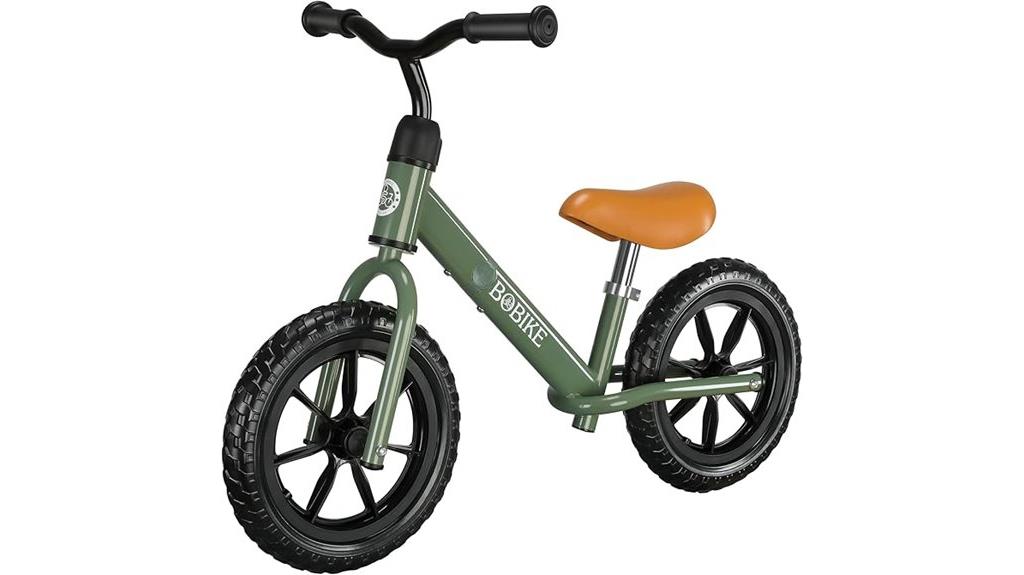
Designed specifically for children aged 2 to 5, toddler balance bikes are the perfect first ride for little ones just starting to explore outdoor play. These bikes help kids develop balance, walking, and early riding skills with features like adjustable seats and handlebars that grow with them. Made from lightweight aluminum and durable steel, they’re safe, stable, and easy to handle. The no-pedal design encourages natural movement, while foam wheels reduce crash risk. Easy to assemble and portable, these bikes are highly rated for their sturdiness, safety certifications, and vibrant Dutch-inspired styles. They make excellent gifts, promoting fun and active outdoor learning.
Best For: parents seeking a safe, beginner-friendly balance bike to help their 2-5-year-old children develop riding skills and enjoy outdoor activities.
Pros:
- Easy to assemble with minimal tools required, saving time and effort
- Sturdy construction from durable steel and aluminum ensures long-lasting use
- Adjustable seat and handlebar accommodate growing children for extended use
Cons:
- Foam wheels are non-replaceable, which may limit longevity if worn out
- No-pedal design may require additional training as children transition to pedal bikes
- Slightly higher price point compared to basic balance bikes with fewer features
12 Inch Toddler Balance Bike with Adjustable Seat for Ages 2-5

The Inch Toddler Balance Bike with Adjustable Seat is an excellent choice for children aged 2 to 5 who are just beginning to learn balance and coordination. Its pedal-free, low-center-of-gravity design promotes natural riding skills while ensuring safety with rounded edges and puncture-resistant tires. The lightweight aluminum frame (only 7.19 pounds) makes it easy for kids to handle and carry. With adjustable handles and seat, it grows with your child, supporting motor development at every stage. Its vibrant colors and modern look appeal to kids and parents alike, making it a fun, practical, and durable way to build confidence on two wheels.
Best For: young children aged 2-5 who are learning to develop balance, coordination, and confidence in riding a bike for the first time.
Pros:
- Promotes natural riding skills with a pedal-free, low-center-of-gravity design.
- Adjustable seat and handles that grow with your child, supporting motor development.
- Lightweight aluminum frame (7.19 lbs) for easy handling, transporting, and storage.
Cons:
- Minor issues reported with tires not spinning freely in some units.
- Limited to children aged 2-5; may not suit older or larger kids.
- Requires assembly, which, although quick, might still be a challenge for some parents.
Ridego Kids’ Balance Bike (12 or 14 Inch, Adjustable Seat)
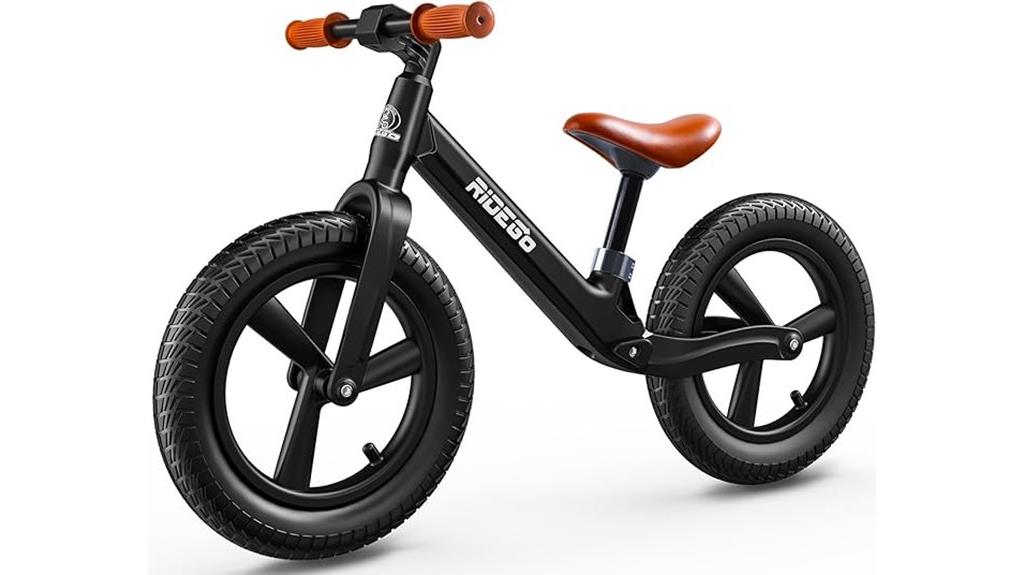
For parents looking to help their young children develop cycling skills confidently, the Ridego Kids’ Balance Bike offers a lightweight and adjustable option suited for kids aged 2 to 7. Crafted from durable glass-reinforced nylon, it features a soft padded saddle, non-slip handlebars, and an adjustable seat ranging from 12.2 to 16.9 inches, ensuring a comfortable fit as your child grows. With maintenance-free EVA foam tires that provide a smooth, puncture-proof ride, it’s perfect for outdoor adventures on sidewalks, trails, or the backyard. Weighing just over 8 pounds, it’s easy to handle and transport, making learning to balance both fun and safe.
Best For: parents seeking a lightweight, adjustable balance bike for children aged 2 to 7 to develop cycling skills outdoors and on various terrains.
Pros:
- Lightweight and easy for young children to handle and carry, weighing only about 8 pounds.
- Adjustable seat height accommodates growth and provides a comfortable fit for children from 2 to 7 years old.
- Maintenance-free EVA foam tires offer a smooth, puncture-proof ride suitable for pavement, trails, and backyard use.
Cons:
- All-plastic construction may lead to concerns about durability and stability, especially for heavier or older children.
- Some users report issues with frame bending, cracking, or breakage within a short period of use.
- Limited to plastic parts, which might not withstand extensive or rough use compared to metal-framed alternatives.
14 Inch Balance Bike for Kids 3-6 Year Old
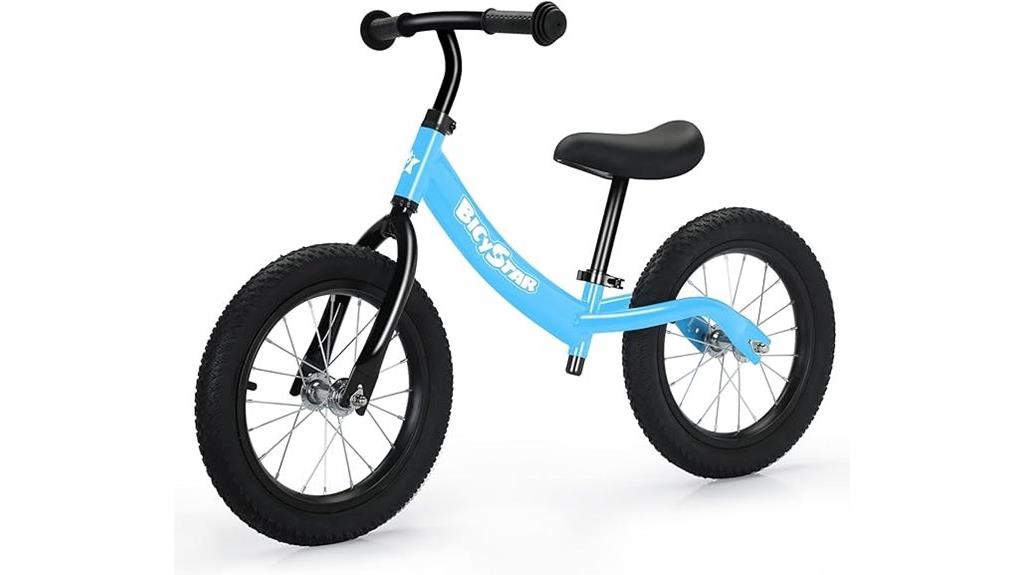
If you’re looking for a balance bike that grows with your child, the 14-inch Inch Balance Bike is an excellent choice for kids aged 3 to 6. It features a lightweight (8.5 lbs) durable carbon steel frame, alloy steel wheels, and air rubber tires, ideal for trail or off-road riding. The bike has adjustable seat (13-21 inches) and handlebar heights (21.6-24 inches), with quick-release mechanisms for easy customization. No pedals or training wheels make learning natural and fun. Kids gain confidence and coordination quickly, making this bike perfect for outdoor adventures and a smooth progression to pedal bikes.
Best For: parents of children aged 3-6 seeking a lightweight, adjustable, and durable balance bike to develop riding skills and confidence outdoors.
Pros:
- Easy to assemble with quick-release adjustments for seat and handlebar height.
- Lightweight (8.5 lbs) and durable carbon steel frame, making it easy for kids to maneuver.
- Suitable for trail and off-road riding with air rubber tires providing stability and traction.
Cons:
- Air tires require occasional inflation and maintenance.
- Lacks accessories like bells or baskets, which might need to be added later.
- Designed for children up to 110 pounds; may be less suitable for older or heavier kids.
16 Inch Balance Bike for Toddlers Ages 5-8

Designed specifically for children aged 5 to 8, the 16-inch balance bike offers an excellent way to build confidence and coordination as they shift to pedal bikes. Its lightweight design (just 10.8 pounds) and low stand-over height make balancing easier and more enjoyable for kids. Features like a bike light, footrests, and no pedals turn practice into outdoor fun. Adjustable from 17 to 24 inches in seat height and 25 to 28 inches in handlebar height, it grows with your child. Durable alloy steel frame, air knobby tires, and rim brakes ensure stability on various terrains, helping kids develop skills naturally and confidently.
Best For: children aged 5 to 8 who are learning to balance and transition to pedal bikes with confidence and stability.
Pros:
- Lightweight (10.8 lbs) and easy to handle for young children.
- Adjustable seat and handlebar heights to accommodate growth and ensure a perfect fit.
- Durable alloy steel frame with off-road capable air knobby tires for versatile terrain riding.
Cons:
- Some users reported missing parts or flat tires upon delivery, requiring support.
- No pedals included, which may delay transition to pedal bikes for some kids.
- Assembly, while straightforward, still requires some time and attention to detail.
Strider 12” Sport Bike for Kids 1-4 Years
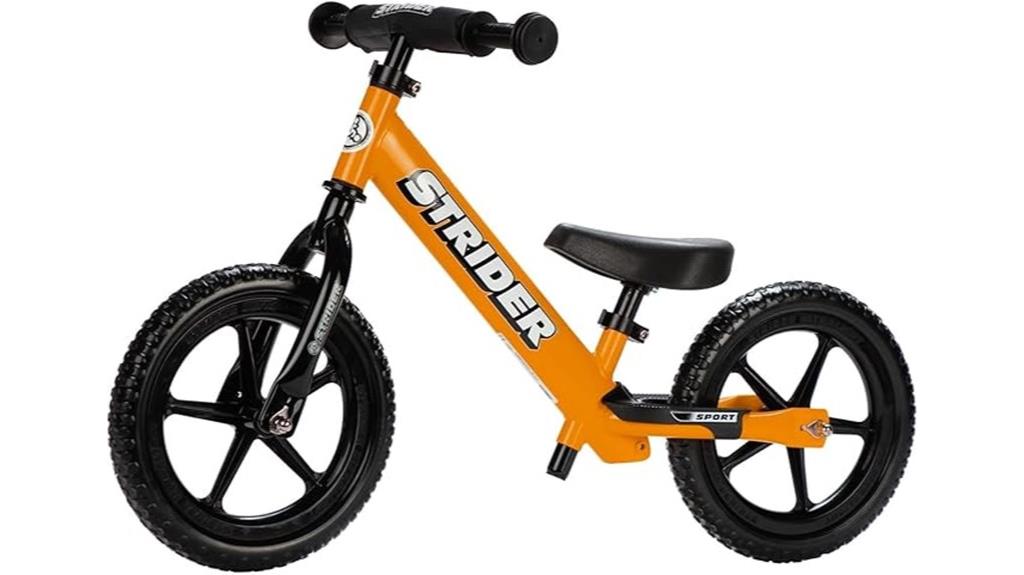
The Strider 12” Sport Bike is an excellent choice for parents seeking a lightweight, durable balance bike for children aged 1 to 4 years. Weighing only 6.7 pounds, it’s easy for little ones to handle and maneuver. Its foam rubber tires are flat-free, ensuring worry-free outdoor play, while the alloy steel frame promises durability across all terrains. The bike’s adjustable seat and handlebar fit children with inseam lengths of 12-18 inches, and assembly is tool-free for convenience. Designed for beginner riders, it promotes balance, coordination, and confidence without the need for pedals, making it a fantastic first bike for young kids.
Best For: parents seeking a lightweight, durable, and adjustable balance bike for children aged 1-4 years to develop confidence and coordination.
Pros:
- Lightweight at only 6.7 pounds, making it easy for young children to handle.
- Flat-free foam tires and durable alloy steel frame suitable for all terrains.
- Easily adjustable seat and handlebar without tools to accommodate growing children.
Cons:
- Absence of brakes may limit control for some young riders.
- Tires can wear down over time with regular use.
- Some users find the price to be on the higher side for a balance bike.
Toddler Balance Bike for 2-5 Year Olds
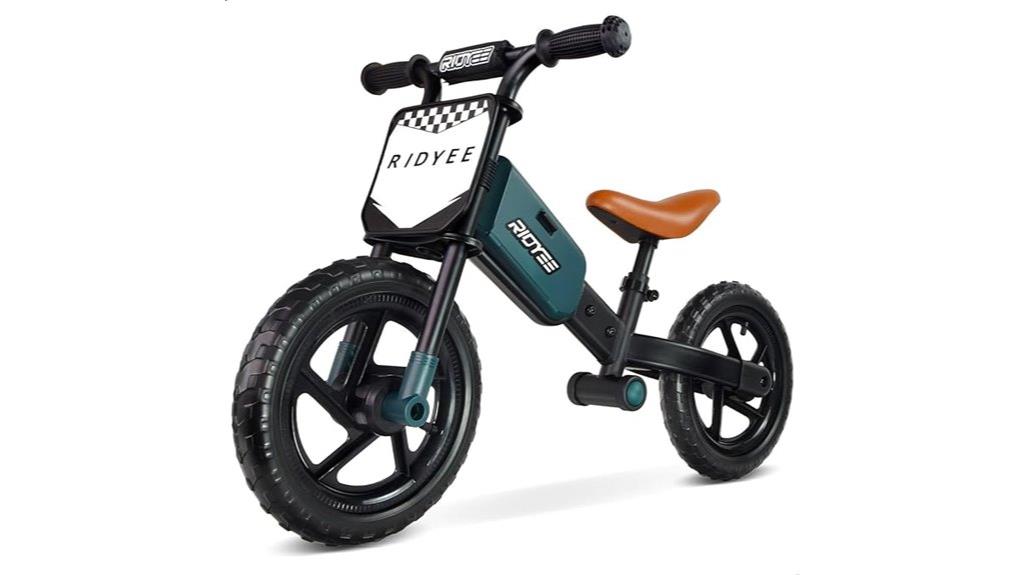
For parents looking to introduce their toddlers to active play and build essential riding skills, the RIDYEE balance bike stands out as an excellent choice for children aged 2 to 5 years. Its stylish sand motocross-inspired design adds excitement, while the sturdy carbon steel frame guarantees durability. The bike features adjustable seat height without tools, limited steering for safety, and all-terrain EVA tires for versatile riding. Safety is prioritized with anti-slip grips, a handlebar pad, and a shock-absorbing seat. Kids can personalize their bike with stickers and a customizable front plate, making riding fun and engaging. Lightweight and easy to handle, the RIDYEE promotes confidence and motor skill development with every ride.
Best For: parents seeking a stylish, safe, and durable first bike to help their 2-5-year-old children develop balance, coordination, and motor skills through active play.
Pros:
- Easy tool-free seat adjustment for growing children
- Durable carbon steel frame with stylish sand motocross-inspired design
- Safe features such as limited steering, anti-slip grips, and shock-absorbing seat
Cons:
- May require some initial assembly for certain accessories
- Limited steering angle may restrict certain types of riding maneuvers
- Slightly higher price point compared to basic balance bikes
Elantrip Balance Bike for Toddlers (1-3 Years)
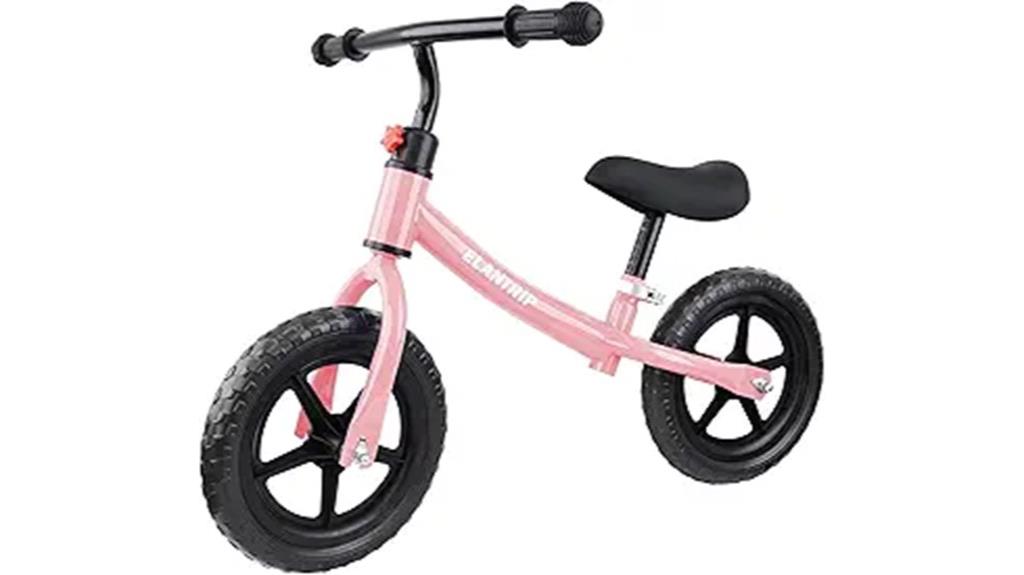
If you’re looking to help your toddler develop balance and coordination early on, the Elantrip Balance Bike is an excellent choice. Designed for ages 1 to 3, it encourages independence and active play without pedals. Made from lightweight aluminum and durable carbon steel, it weighs just 7 pounds and can support up to 110 pounds. The adjustable seat and handlebar fit children from 13.7 to 17.3 inches, with tires that are puncture-proof and suitable for gravel. Easy to assemble in minutes, this bike offers a smooth ride thanks to high-quality bearings, making it a reliable, safe, and fun way for your little one to learn to ride.
Best For: parents and caregivers seeking a lightweight, durable, and adjustable balance bike to help toddlers aged 1-3 develop balance, coordination, and confidence in riding.
Pros:
- Lightweight and easy to carry, weighing only 7 pounds for effortless handling.
- Adjustable seat and handlebar to grow with your child, accommodating ages 1 to 3 years.
- Durable construction with puncture-proof EVA foam tires suitable for gravel and various terrains.
Cons:
- Some users have noted the foam tires may wear out faster or lack cushioning on rough surfaces.
- Handlebar bolt design may loosen over time, requiring periodic tightening for safety.
- Limited to a single-speed design with no additional gear options or features.
KRIDDO Toddler Balance Bike for 2-5 Years Old

Children aged 2 to 5 will find the KRIDDO Toddler Balance Bike to be an ideal beginner bike that grows with them. Its adjustable seat and handlebar allow for a customized fit as your child develops, making it a long-lasting choice. The bike’s lightweight, durable carbon steel frame ensures stability and easy handling. With fun customization options like flower and clover plates, kids stay engaged. The all-terrain puncture-proof tires provide smooth rides on various surfaces, promoting confidence and balance. Overall, it’s a versatile, sturdy bike that helps toddlers shift seamlessly from balance to pedaling.
Best For: children aged 2-5 years who are learning to develop balance and coordination through a safe, adjustable, and versatile beginner bike.
Pros:
- Adjustable seat and handlebar to grow with your child, ensuring long-term use
- Smooth, all-terrain puncture-proof tires suitable for various surfaces
- Lightweight and durable carbon steel frame for easy handling and stability
Cons:
- Plastic wheels can bend easily over time, affecting durability
- Assembly required, which may be challenging for some parents
- No available replacement parts, potentially limiting longevity in case of damage
KRIDDO Toddler Balance Bike for Ages 2-5
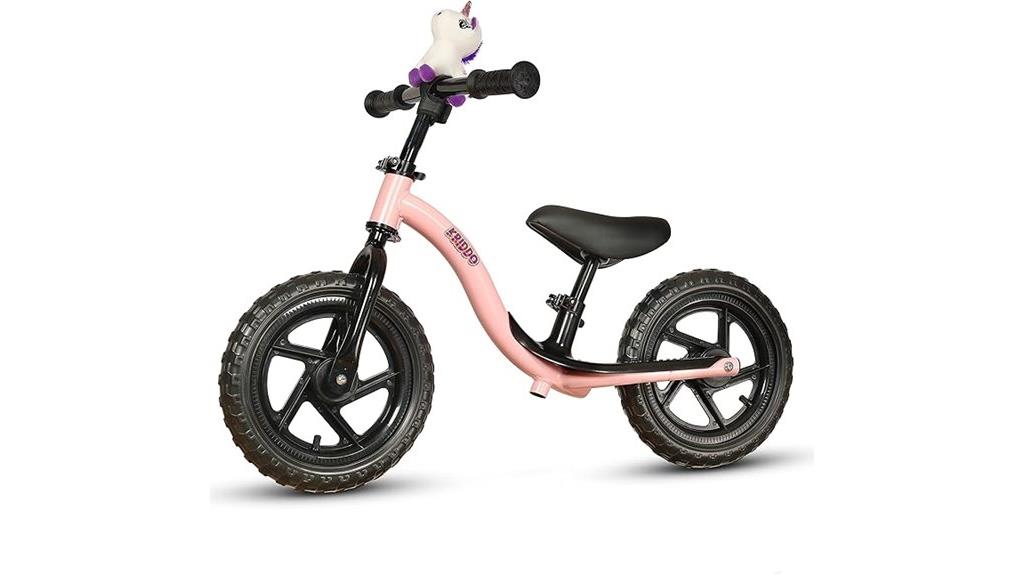
The KRIDDO Toddler Balance Bike stands out as an ideal first bike for kids aged 2 to 5 years, thanks to its adjustable features that grow with your child. Its lightweight, sturdy carbon-steel frame makes it easy for little ones to handle, while the adjustable seat and handlebars ensure a perfect fit as they develop. Designed for both indoor and outdoor use, it features puncture-resistant tires, widened wheels for stability, and soft rubber grip handlebars for safety. With no brakes, children learn to balance and stop naturally using their feet. The bright colors, fun decals, and included stuffed animal make it an engaging and confidence-boosting ride for young beginners.
Best For: young children aged 2 to 5 years who are learning to balance and riding a bike for the first time.
Pros:
- Adjustable seat and handlebars to accommodate growth and ensure a comfortable fit.
- Lightweight and durable carbon-steel frame for easy handling and longevity.
- Safety features like widened wheels, puncture-resistant tires, and limited steering for stability and security.
Cons:
- No brakes included, so children rely solely on foot stopping, which may not be suitable for all surfaces.
- The front wheel handlebars follow the front wheel without locking, potentially requiring occasional adjustments.
- Some users suggest that the wheels could benefit from softer rubber for better indoor use.
Factors to Consider When Choosing Kids’ Balance Bikes

When selecting a balance bike for your child, it’s important to take into account factors like age, size, and fit to ensure comfort and proper development. Safety features and material durability also play a key role in making a smart choice. Additionally, adjustable options can help the bike grow with your child, making it a worthwhile investment.
Age Appropriateness
Choosing the right balance bike depends heavily on matching the bike’s size and features to your child’s age and developmental stage. For the best fit, select a bike with seat height and wheel size appropriate for your child’s age and height, ensuring they can reach the ground comfortably. For toddlers aged 1-3, look for 12-inch bikes with safety features like limited steering angles or no pedals, which help build confidence. Older children, aged 4-8, benefit from 14-16 inch bikes that support their growing motor skills and include adjustable seats and handlebars for continued comfort. Always consider your child’s motor skill level—an age-appropriate bike will encourage skill development and confidence without feeling overwhelming or too easy. Proper age alignment makes learning to ride safer and more enjoyable.
Size & Fit
Selecting the right size and fit for a kids’ balance bike is vital to guarantee your child rides comfortably and safely. Start by making sure the seat height is adjustable, ideally from 11 to 18 inches, allowing room for growth. The frame size and wheel diameter should match your child’s age and height—12, 14, or 16 inches are common options. Check that the bike’s overall dimensions and weight suit your child’s strength and ability to handle it easily. It’s also important to verify the handlebar height can be adjusted to prevent arm and back strain. Finally, make certain your child’s feet can touch the ground when seated, providing stability and confidence while riding. Proper sizing promotes a positive learning experience and safety from the start.
Safety Features
Safety features are essential considerations that can substantially reduce the risk of accidents and injuries while your child is riding a balance bike. I look for bikes with limited steering angles, rounded edges, and enclosed wheels to help prevent falls and scrapes. Non-slip handlebar grips and soft, padded seats keep my child comfortable and in control during rides. Puncture-resistant tires and sturdy frames provide stability across different terrains, reducing the chance of flats or collapses. I also prefer bikes without pedals and training wheels, as they simplify the learning process and focus on developing balance safely. Finally, I check for certification standards like ASTM F963-11 and EN71, which ensure the bike meets safety regulations for children’s products and give me peace of mind.
Material Durability
The material durability of a balance bike plays a significant role in how well it holds up over time and through rough outdoor use. I look for bikes with sturdy frame materials like steel or aluminum, as they’re more resilient than plastic. All-terrain tires made of puncture-resistant EVA foam or rubber last longer and handle rough surfaces better than soft plastic tires. The quality of joints, welds, and fasteners also matters because they prevent cracks, loose parts, or breakage as kids ride and grow. A well-built bike with durable materials can support children up to its weight capacity without bending or cracking. Regular maintenance, such as tightening bolts and checking for wear, helps preserve its strength and ensures safe, long-lasting use.
Adjustability Options
Choosing a kids’ balance bike that offers good adjustability guarantees it can grow with your child, making it a worthwhile investment. Adjustable handlebar heights usually range from 18 to 22 inches, fitting children from 18 months to several years old. Seat height can often be modified from 11 to 18 inches, ensuring proper posture and comfort as your child grows. Many bikes feature quick-release mechanisms, allowing parents to make adjustments easily without tools—perfect for on-the-fly changes. Some bikes offer multiple preset height options, while others provide continuous adjustments for a more precise fit. This flexibility promotes longer usability, supporting your child’s development through different stages and ensuring safe, comfortable riding at every age.
Terrain Compatibility
Selecting a kids’ balance bike that matches the terrain your child will ride on is essential for a smooth and safe experience. If your child will ride outdoors on trails or rough surfaces, look for bikes with all-terrain tires that are puncture-resistant to prevent flats. Wider tires and suspension systems help absorb shocks and smooth out bumps, making off-road riding more comfortable. For indoor use or smooth pavements, foam tires are lightweight and quiet, ideal for limited space. Pay attention to tire width and tread pattern; knobby tires provide better grip on dirt or grass, ensuring stability and safety. Additionally, ensure the bike’s frame and wheels are durable enough to handle the stresses of different terrains without compromising safety or performance.
Budget Considerations
Balancing cost with quality is an important step when picking a kids’ balance bike. Prices vary widely, from around $50 for basic models to over $200 for premium options with extra features. While budget bikes can be affordable, they often have limited adjustability, fewer safety features, and may use lower-quality materials, which can affect durability and safety. Spending a bit more upfront on a bike with durable materials and adjustable parts can provide better long-term value. Keep an eye out for sales, discounts, and bundle deals, as these can make higher-end bikes more accessible. Also, consider the cost of accessories or replacement parts, since cheaper bikes might lead to higher maintenance expenses over time. Finding the right balance ensures safety, longevity, and enjoyment.
Frequently Asked Questions
What Safety Features Are Common in Kids’ Balance Bikes?
I find that common safety features in kids’ balance bikes include sturdy, non-slip tires for better grip, low seat heights for stability, and lightweight frames for easy handling. Many bikes also have soft, rounded edges to prevent injuries, and some include hand brakes for added control. These features give both kids and parents peace of mind, making the learning process safer and more enjoyable.
How Do I Determine the Right Size for My Child?
Choosing the right size for your child’s balance bike is like fitting a glove—comfort and control are key. I measure their inseam and compare it to the bike’s seat height, ensuring they can sit comfortably with a slight bend in the knees. If possible, let them sit on the bike to test reach and stability. A properly sized bike makes learning smooth and enjoyable, boosting their confidence to ride away.
Are Lightweight Bikes Better for Beginners?
Yes, lightweight bikes are better for beginners because they’re easier for kids to handle and control. I’ve found that a bike that’s too heavy makes it harder for them to balance and learn quickly. When choosing, I look for bikes with a lightweight frame, ideally under 10 pounds, so my child can focus on riding confidently without struggling with the weight. It really helps build their skills and confidence faster.
Can Balance Bikes Be Used Indoors Safely?
Absolutely, balance bikes can be a safe indoor adventure if you set the scene right. I always make sure the space is clear of sharp edges and obstacles, turning my living room into a mini race track. Soft rugs or foam mats act like a gentle cushion for little falls. With a little supervision and a cozy setup, indoor riding becomes a fun, safe way for kids to master balance.
How Long Do Kids Typically Use a Balance Bike Before Transitioning?
Kids typically use a balance bike for about 6 months to a year before shifting to a pedal bike. During this time, they develop essential skills like balance and coordination, making the switch smoother. I’ve seen children progress quickly if they practice regularly and feel confident. Every child is different, so I recommend watching for signs of readiness, like gliding confidently and steering easily, before moving on.
Conclusion
I know choosing the right balance bike can feel overwhelming, but remember, it’s all about finding one that fits your child’s size and confidence level. Even if it seems like a small step, a good bike makes learning fun and safe. Don’t worry if your little one takes a bit longer—every child learns at their own pace. With patience and the right bike, they’ll be riding confidently before you know it!


